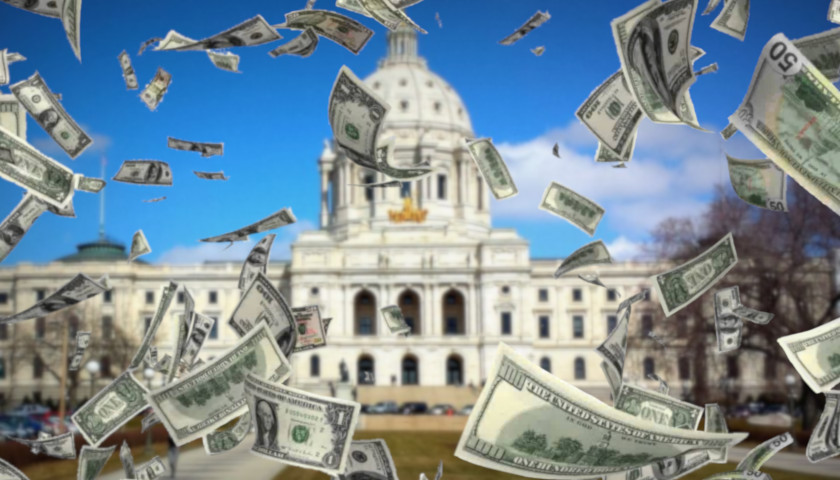by Scott McClallen
While Minnesota is recovering from a 2020 budget deficit and public health hangover, Gov. Tim Walz proposed a $52.4 billion budget – a $4 billion spending increase from the prior biennium budget and the largest proposed spending plan in state history.
“As a result of rising costs and inflation, it is expected that budgets will increase biennium to biennium,” Minnesota Management and Budget (MMB) spokesman Chris Kelly told The Center Square in an email.
“In recent history, the only biennial (actual not proposed) budget that has been less was the 2010-11 biennial budget due to [American Recovery & Reinvestment Act] federal dollars and school shifts.”
Republicans who called for a 5% spending cut across the board instead were offered a $1.63 billion tax hike on higher earners ($500 million for single-earners, $1 million for joint filers) and corporate businesses, as well as an increase in taxes on nicotine and tobacco products.
Much of that possible new revenue would boost K-12 education by $745 million, enacting a wide range of programs aimed to help plug learning leaks from almost an entire year of virtual learning.
Walz’s budget only cuts $150 million, or 0.3% of total spending in the next two years.
“Last year, Governor Walz asked Minnesotans to tighten their belts by shutting down schools, businesses, and restaurants in order to try to combat COVID-19,” Sen. Andrew Mathews, R-Princeton, said in a Tuesday statement.
“As a result, many of you lost income, savings, retirements and investments, and many of you had to take advantage of grants or loans to try to stay afloat. This year, it is time for government to tighten its belt and not continue piling on Minnesotans by raising their taxes even more.”
Sen. Julie Rosen, R-Vernon Center, argued Walz shouldn’t use $130 million from U.S. Bank Stadium funds meant to pay off taxpayer-funded stadium debt to fix a projected $1.3 billion deficit.
“It’s ridiculous that the governor needs to raid a fund that could possibly save the state $200 million with refinancing,” Rosen said. “How much more money does he need to spend?”
Walz aims to increase the corporate franchise tax rate from 9.8% to 11.25% starting in 2021, expected to reap $424 million.
That increase would bump Minnesota to the second-highest corporate rate in the nation behind New Jersey at 10.5%, according to the Tax Foundation.
The rate is applied to income apportioned to Minnesota based on the in-state percentage of sales for corporations operating in multiple states, Department of Revenue Communications Director Shane Delaney said.
Delaney added that about 34,400 C-corporations file a corporate franchise tax return annually.
Walz plans to use $1.04 billion from the rainy day fund to partly bridge a projected $1.3 billion budget deficit in fiscal year 2022-23.
Mike Hickey, Minnesota State Director for the National Federation of Independent Businesses, told The Center Square the state doesn’t need a tax increase during a pandemic.
“It’s definitely more than raining,” Hickey said, suggesting the state use a greater amount of the nearly $2.4 billion rainy day fund, the balance which will decrease by $491 million in fiscal year 2022, according to a 2019 budget deal.
“To us, that would be preferable to damaging tax increases that harm the economy,” Hickey said. “This is really a wrong direction for a pandemic-driven recession; to be putting tax increases on job producers is really a mistake.”
Others argued the budget was well-needed.
“Standing up for Minnesota workers and families hit hardest by the pandemic must be the Legislature’s top priority right now,” House Majority Leader Ryan Winkler, DFL-Golden Valley, said in a statement.
“COVID-19 has further divided Minnesota by income and race, and we cannot just return to the pre-pandemic status quo of haves and have-nots. A state government that serves the rich and well-connected is not doing the work of the people.”
– – –
Scott McClallen is a staff writer covering Michigan and Minnesota for The Center Square. A graduate of Hillsdale College, his work has appeared on Forbes.com and FEE.org. Previously, he worked as a financial analyst at Pepsi.
Photo “Minnesota Capitol” by Gabriel Vanslette. CC BY 3.0.





